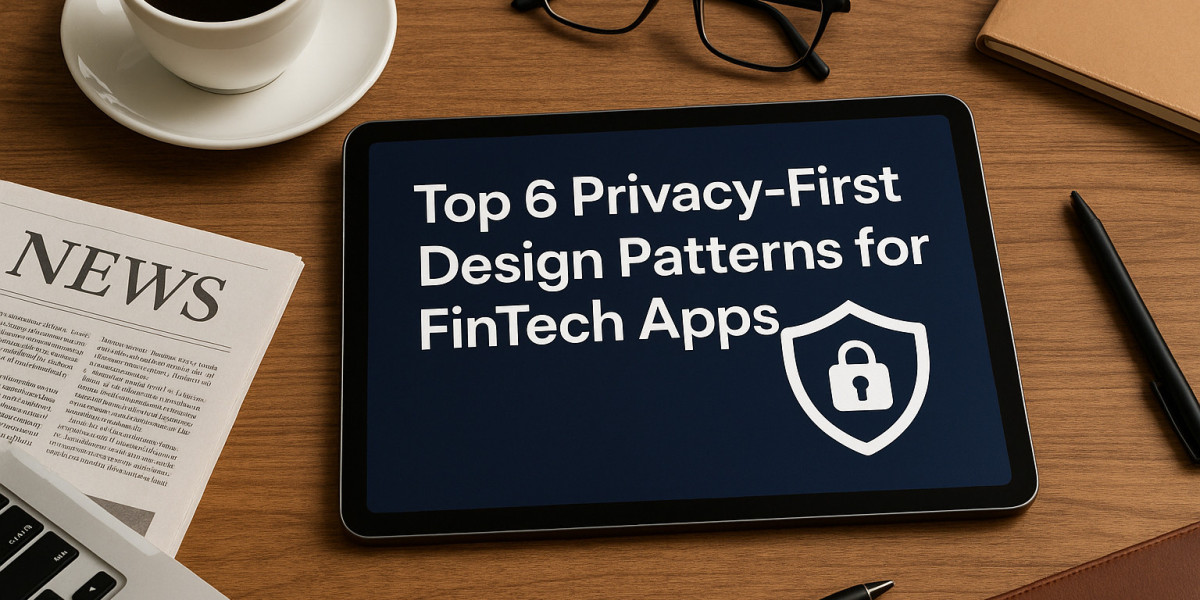In the rapidly evolving FinTech landscape, where mobile applications handle highly sensitive financial data, user trust is not just a desirable trait—it's the bedrock of success. Breaches of privacy can have catastrophic consequences, leading to massive financial losses, irreparable reputational damage, and severe regulatory penalties. This makes privacy-first design an absolute imperative for any financial technology app.
Privacy-first design is an approach that embeds data protection and privacy considerations into the very core of a product or service, from the initial concept to its final deployment and ongoing maintenance. It's about proactively building in safeguards rather than reactively addressing vulnerabilities. For any Mobile App Development Agency specializing in FinTech, a deep understanding and rigorous implementation of these design patterns are crucial for creating secure, compliant, and trustworthy applications that empower users while protecting their most valuable asset: their personal and financial information.
Here are 6 top privacy-first design patterns that every FinTech app must adopt:
1. Data Minimization (Collection & Retention)
The principle of data minimization dictates that FinTech apps should only collect, process, and store the absolute minimum amount of personal and financial data necessary to achieve their stated purpose. Less data means less risk.
How to implement:
- Purpose Limitation: Clearly define the specific, legitimate purpose for which each piece of data is collected. If data doesn't directly serve that purpose, it shouldn't be collected. For instance, a basic budgeting app might not need access to a user's contact list.
- Just-in-Time Data Collection: Only ask for information precisely when it's needed for a specific action or feature. Avoid collecting all possible data during onboarding if it's not immediately relevant. For example, request bank account details only when a user initiates a transaction, not just upon registration.
- Ephemeral Data: Design systems to process and discard transient or temporary data as soon as its purpose is fulfilled. Session tokens, temporary calculation results, or one-time verification codes should be handled as ephemeral data.
- Data Anonymization/Pseudonymization: Whenever possible, use anonymized or pseudonymized data for analytics, testing, or development environments. This means removing or scrambling identifying information so that individual users cannot be linked back to the data. This significantly reduces risk in non-production environments.
- Strict Retention Policies: Implement and enforce clear data retention policies. Data should only be kept for as long as legally required or strictly necessary for the app's functionality, after which it should be securely deleted or anonymized.
2. Strong User Control and Granular Permissions
Empowering users with control over their data is a cornerstone of privacy-first design. This means providing clear, intuitive mechanisms for users to manage their privacy settings and understand how their data is being used.
How to implement:
- Transparent Consent: Obtain explicit, informed consent for data collection and processing. Users should understand what data is being collected, why, and how it will be used, before they agree. Avoid vague blanket consents.
- Granular Permissions: Allow users to grant or deny access to specific types of data or device functionalities (e.g., location, contacts, camera) on a granular level. Users should be able to revoke these permissions at any time through easily accessible settings within the app.
- Clear Privacy Dashboard: Provide users with a centralized, easy-to-understand privacy dashboard within the app. This dashboard should clearly display what data is being collected, who it's shared with (if anyone), and provide options to review, edit, download, or delete their data.
- "Explain My Data" Feature: Consider features that explain why certain data points are needed for specific app functionalities. For example, if a budgeting app needs transaction data, explain that it's for categorizing spending and offering insights.
- Right to Be Forgotten & Data Portability: Implement mechanisms that allow users to easily request deletion of their data (Right to Be Forgotten) or obtain a copy of their data in a portable format (Data Portability), in compliance with regulations like GDPR.
3. End-to-End Encryption
Encryption is a fundamental technical safeguard for protecting sensitive financial data both in transit and at rest. End-to-end encryption ensures that data is encrypted from the point it leaves the user's device until it reaches its intended recipient, and only the sender and receiver can decrypt it.
How to implement:
- Data in Transit (TLS/SSL): All communication between the mobile app and backend servers must be secured using robust encryption protocols like TLS (Transport Layer Security) or SSL (Secure Sockets Layer). This prevents eavesdropping during data transmission. Implement certificate pinning to prevent Man-in-the-Middle (MitM) attacks.
- Data at Rest (Device & Server): Sensitive data stored locally on the user's device (e.g., payment credentials, transaction history) must be encrypted using strong, device-level encryption. On backend servers, all sensitive financial data should be encrypted both at the database level and through file system encryption.
- Tokenization/Pseudonymization for Payment Data: For payment card information, implement tokenization where actual card numbers are replaced with unique, randomly generated tokens. This minimizes the exposure of sensitive payment data.
- Secure Key Management: Employ robust key management practices, ensuring encryption keys are securely generated, stored, distributed, and rotated. Avoid hardcoding keys within the app's code.
4. Decentralized or Federated Learning (Where Applicable)
In scenarios where AI/ML models are used to improve app functionality or personalize experiences, decentralized or federated learning can enhance privacy by preventing raw data from leaving the user's device.
How to implement:
- Model Training on Device: Instead of sending raw user data to a central server for model training, machine learning models are downloaded to the user's device. The model is then trained locally using the user's data, and only the updated model parameters (not the raw data) are sent back to the server for aggregation.
- Differential Privacy: Implement techniques that add noise to the aggregated model updates or the raw data before processing. This ensures that individual data points cannot be precisely identified, even if sophisticated analysis is applied to the aggregate data.
- Minimizing Data Export: This pattern significantly reduces the volume of sensitive data transmitted to the cloud, enhancing privacy while still allowing for the benefits of personalized AI models (e.g., for fraud detection, personalized financial advice, or behavioral analytics).
- Use Cases: Ideal for features like personalized recommendations, improved predictive text, or fraud detection models that benefit from user-specific data but do not require direct access to that raw data centrally.
5. Secure Default Settings (Privacy by Default)
Privacy by Default means that when a user first downloads and installs a FinTech app, the default settings should be the most privacy-protective options available. Users should have to actively opt-in to less private settings, rather than opt-out.
How to implement:
- Opt-in for Data Sharing: Any data sharing with third parties or for secondary purposes (e.g., marketing, analytics beyond core functionality) should be opt-in, not opt-out.
- Minimal Permissions by Default: The app should only request essential permissions during installation. Additional permissions should be requested contextually later when a feature requiring them is used.
- Default to Dark Mode (if applicable to privacy/energy): While primarily an energy-saving feature, this can be part of a broader "privacy-conscious" default design if it minimizes data broadcast from screen.
- Limited Data Access: Ensure that the app, by default, has access only to the data strictly necessary for its immediate operation.
- Pre-configured Security: Default security settings like two-factor authentication (2FA) should be prominently offered or even enabled by default (with clear instructions for setup). Session timeouts should be short by default for sensitive financial transactions.
6. Transparent and Regular Privacy Audits & Communication
Privacy-first design is an ongoing commitment, not a one-time implementation. Regular audits and clear communication with users about privacy practices build and maintain trust over time.
How to implement:
- Regular Privacy Audits: Conduct frequent, independent privacy audits of the app's code, infrastructure, and data handling processes. This includes penetration testing, vulnerability assessments, and compliance checks against relevant regulations (e.g., GDPR, CCPA, industry-specific standards).
- Clear Privacy Policy: Maintain an easily accessible, comprehensive, and clear privacy policy that is written in plain language, not legalese. It should explain data collection, usage, storage, sharing practices, and user rights.
- Proactive Breach Notification: In the unfortunate event of a data breach, promptly and transparently notify affected users and relevant authorities, outlining the nature of the breach, its potential impact, and steps being taken to mitigate it.
- Privacy-Focused Updates: Highlight privacy enhancements in app updates and release notes. This demonstrates a continuous commitment to data protection.
- User Education on Security: Provide in-app tips and resources to educate users on general digital security best practices (e.g., creating strong passwords, recognizing phishing attempts, avoiding public Wi-Fi for sensitive transactions).
Conclusion
In the hyper-sensitive realm of FinTech, trust is the ultimate currency. Implementing a privacy-first design approach is paramount for any mobile app in this sector. By integrating data minimization, robust user controls, end-to-end encryption, decentralized learning, secure default settings, and transparent privacy audits, a Mobile App Development Agency can build applications that not only comply with stringent regulations but also genuinely earn and maintain user confidence. Prioritizing privacy from concept to deployment ensures that FinTech apps are not just functional and innovative, but also secure, ethical, and ultimately, successful in empowering users with financial freedom while rigorously protecting their sensitive information.








